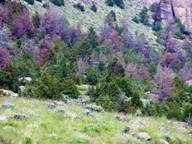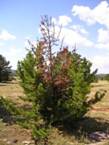THREATS SUMMARY
 There are significant concerns about the sustainability of high elevation white pine ecosystems. As more high elevation ecosystems are being impacted, there is a threat of diminished western ecosystem diversity, as well as reduced opportunity to understand their components and function more entirely.
There are significant concerns about the sustainability of high elevation white pine ecosystems. As more high elevation ecosystems are being impacted, there is a threat of diminished western ecosystem diversity, as well as reduced opportunity to understand their components and function more entirely.
Some of the concerning threats to high elevation white pine ecosystems  include human introduced stressors such as white pine blister rust, fire exclusion and climate change, and natural stressors such as bark beetles and dwarf mistletoe.
include human introduced stressors such as white pine blister rust, fire exclusion and climate change, and natural stressors such as bark beetles and dwarf mistletoe.
One of the most extensive threats is the non - native pathogen (Cronartium ribicola ) that causes the lethal disease white pine blister rust. Trees infected with the rust fungus develop cankers on the branches and main stem that eventually cause the tree to die.
 Currently, several management approaches are available to mitigate impacts caused by white pine blister rust yet none have proven to be completely effective and suitable for the low elevation white pines (such as eastern white pine, western white pines and sugar pine); tests have only just begun to assess their potential effectiveness for high elevation white pines. The combined impact of tree mortality caused by blister rust and bark beetles is likely to have long - lasting impacts on populations of high elevation white pines.
Currently, several management approaches are available to mitigate impacts caused by white pine blister rust yet none have proven to be completely effective and suitable for the low elevation white pines (such as eastern white pine, western white pines and sugar pine); tests have only just begun to assess their potential effectiveness for high elevation white pines. The combined impact of tree mortality caused by blister rust and bark beetles is likely to have long - lasting impacts on populations of high elevation white pines.
